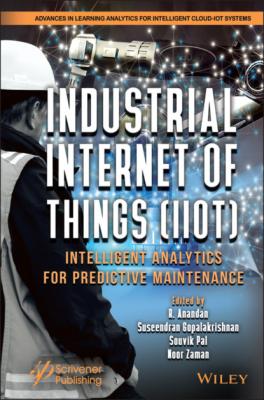Industrial Internet of Things (IIoT). Группа авторов
Читать онлайн.| Название | Industrial Internet of Things (IIoT) |
|---|---|
| Автор произведения | Группа авторов |
| Жанр | Программы |
| Серия | |
| Издательство | Программы |
| Год выпуска | 0 |
| isbn | 9781119769002 |
Library of Congress Cataloging-in-Publication Data
ISBN 978-1-119-76877-7
Cover image: Pixabay.Com Cover design by Russell Richardson
Set in size of 11pt and Minion Pro by Manila Typesetting Company, Makati, Philippines
Printed in the USA
10 9 8 7 6 5 4 3 2 1
Preface
It is with immense pleasure that we introduce this book on intelligent analytics for predictive maintenance through the industrial internet of things (IIoT), with the objective of fostering advancements and disseminating results concerning recent applications in the field.
Since the internet of things (IoT) dominates all sectors of technology, from home to industries, automation through IoT devices is remarkably changing the processes of our daily lives. For example, more and more businesses are adopting and accepting industrial automation on a large scale, with the market for industrial robots expected to reach 73.5 billion US dollars by 2023. The primary reason for adopting IoT industrial automation in businesses is the benefits it provides, including enhanced efficiency, high accuracy, cost-effectiveness, quick process completion, low power consumption, fewer errors, and ease of control. Therefore, every smart entrepreneur undoubtedly has the vision of automating office processes to match the latest technological innovations. However, it is not so easy to use these same innovations to automate industrial processes. Which is why the IIoT, a key element of a smart factory, was created to bring together modern cloud computing, the IoT, and AI to design intelligent, self-optimizing industrial equipment and facilities.
Since engineers, both current and future, need systematic training in industrial automation in order to keep up with and advance the rapidly evolving field of applied control technologies, expert systems with IoT capabilities make for more versatile and innovative handling of problems. However, since security of both physical devices and administration applications is basic to the activity of the IoT and is imperative for its success, this book was designed to provide students with an opportunity to explore knowledge concerning the security frameworks of the IoT that are dependent on new specialized norms. Therefore, new security plans are discussed which highlight these new norms.
This book showcases industrial automation through the IoT by including case studies in the areas of the IIoT, robotic and intelligent systems, and web-based applications which will be of interest to working professionals and those in education and research involved in a broad cross section of technical disciplines. The diverse topics covered in the 15 chapters herein are briefly described below.
– Chapter 1 provides an updated overview of the IoT and IIoT, addressing its evolution along with AI technology and its potential in the industry, approaching its relationship with a concise bibliographic background, and synthesizing the potential of the technologies.
– Chapter 2 discusses the major challenges in securing IoT devices and the data being exchanged over the network. It also covers the manufacturers of IoT devices and the standards they follow. Security challenges such as privacy, confidentiality, integrity and reliability are also discussed in a broader manner.
– Chapter 3 extensively covers the challenges concerning smart automation, and smart and grid management.
– Chapter 4 focuses on how advanced forms of automated data processing connect with new types of computer vision (CV) applications that directly influence safety, thereby protecting human lives and physical assets in hazardous places.
– Chapter 5 explains the use of precise system modeling along with appropriate objective function that can offer optimal solutions, along with the financial implications of using soft computing techniques.
– Chapter 6 provides insightful knowledge on antenna designs, which can further help in future wearable antenna design research to fulfil the requirements of best wearable electronics.
– Chapter 7 briefly reports on the numerous IoT devices used in daily life. Since the data generated by these devices are huge, there is a discussion on how it should be monitored, controlled, and acted upon using IoT data transmission protocols in data centers using various computing methods such as Fog, Cloud, Edge, and distributed computing along with machine learning techniques. Challenges faced in data centers and the IoT are also presented.
– Chapter 8 provides insight into the challenges of drone delivery system and the use of IoT to overcome them.
– Chapter 9 studies IoT-based water management system, including investigations of rate impediments in biophysical and geochemical measures to help biological system administrations concerning water quality.
– Chapters 10 and 11 further emphasize the numerous advantages of the industrial IoT.
– Chapter 12 introduces a novel neural predictive classifier for improving the prediction rate of adverse drug reactions (ADRs), which is proposed to identify ADRs using the IoT.
– Chapter 13 explains the impact that COVID-19 has had on the IIoT and gives an overview of IoT’s role in COVID-19, the benefits and challenges of the IIoT, and the effects of COVID-19 on industrial manufacturing and its impact on IoT-connected applications and digital transformation, and also the influence of COVID-19 on IoT application in general.
– Chapter 14 paves the way for a comprehensive composite smart ambulance booking and tracking system using the IoT for digital services.
– Chapter 15 discusses the increasing demand to solve health issues affecting the elderly, where the use of new IoT technology is completely changing their everyday lives, and promises to revolutionize modern healthcare by enabling a more personalized, preventive and collaborative form of care. Embedding devices with a cloud server and the sensor-cloud paradigm will give the elderly a more versatile facility. So, by analyzing security problems, such as authentication and data protection to protect the privacy of the elderly, an intelligent and safe health control system
